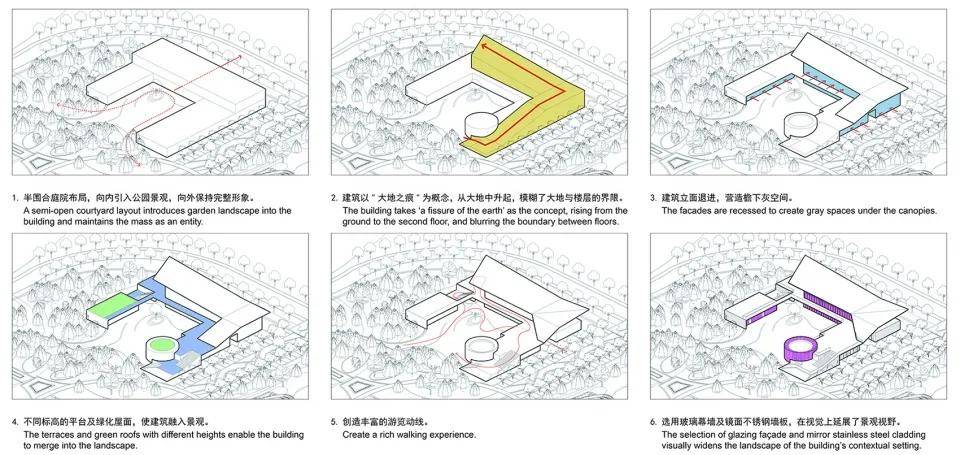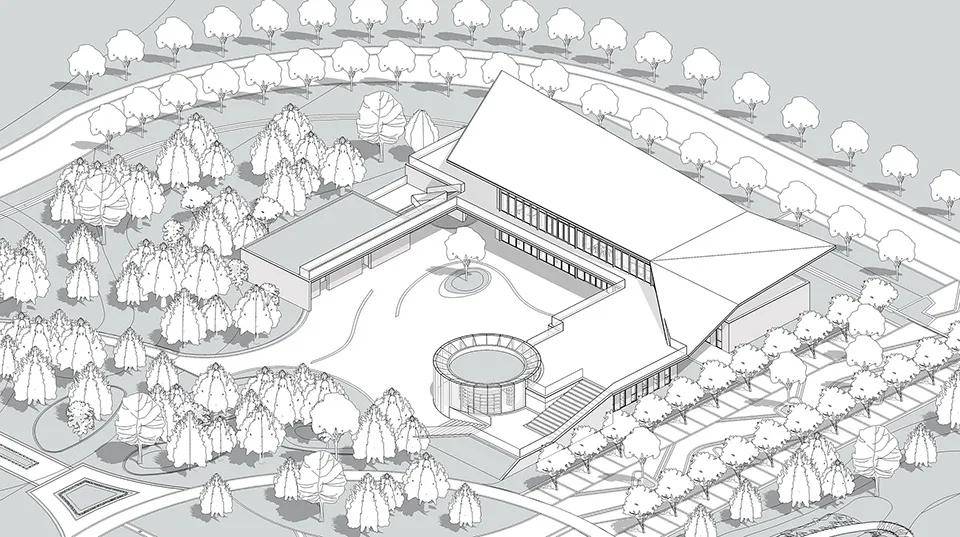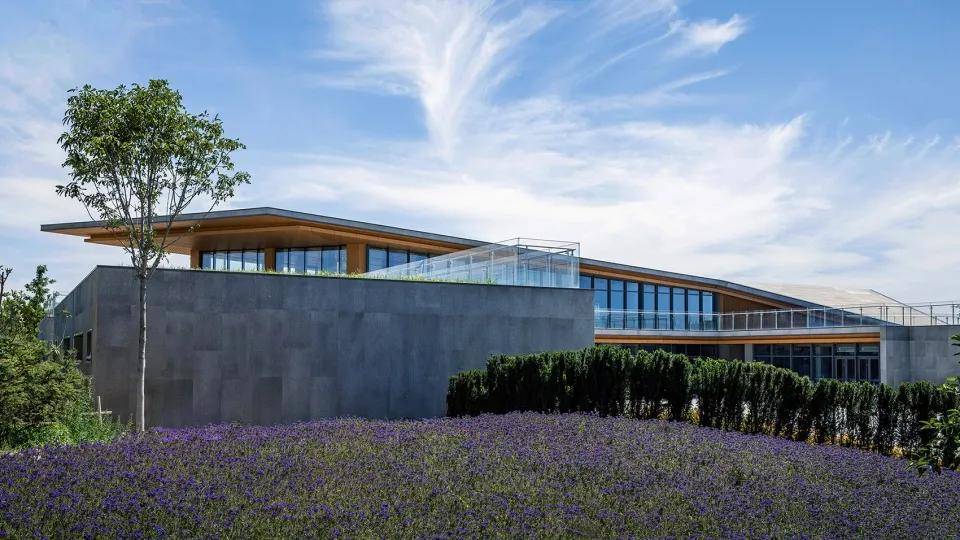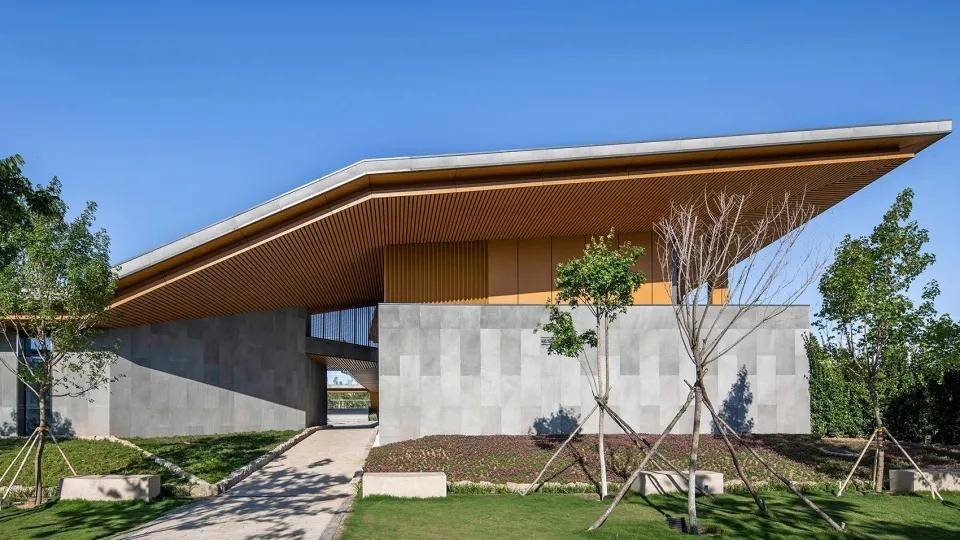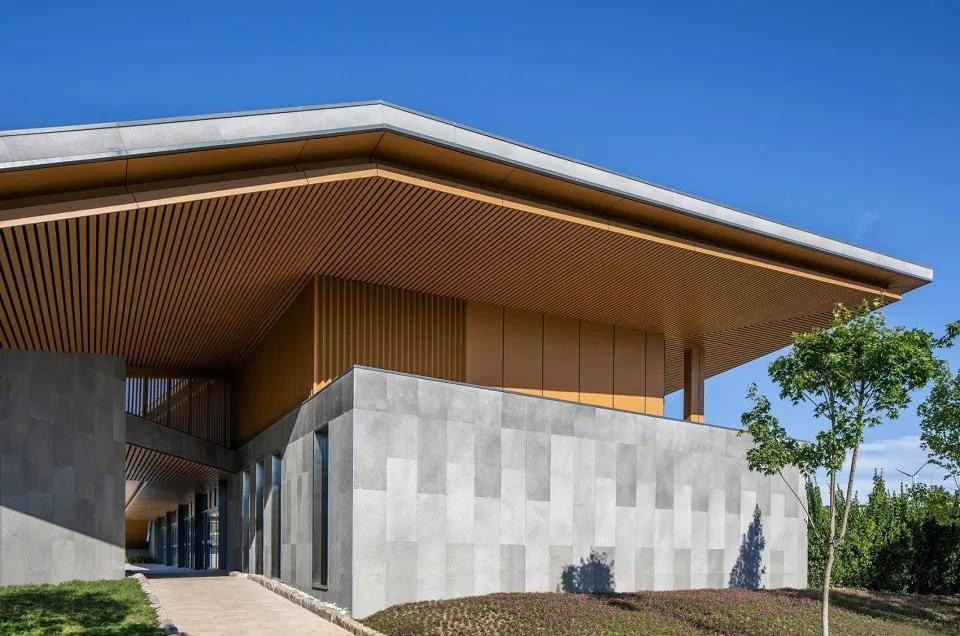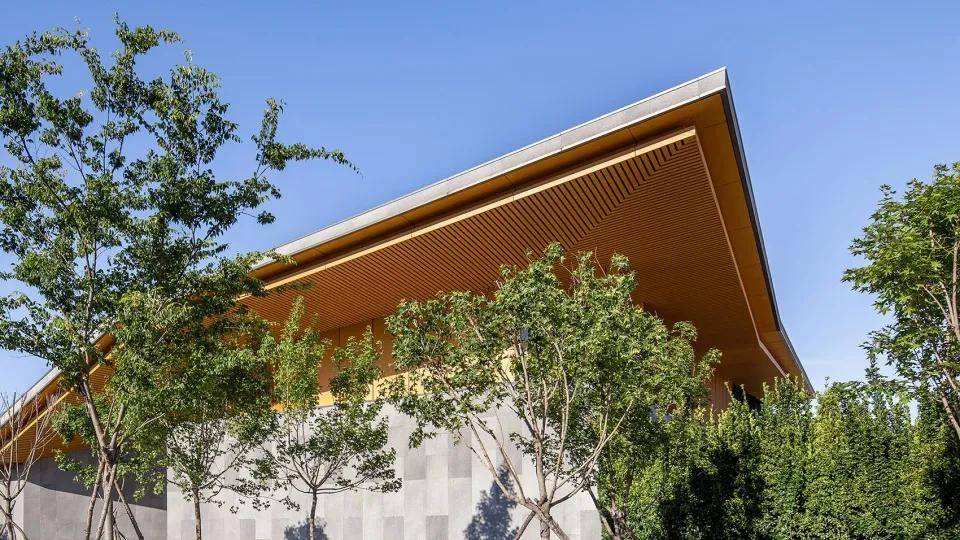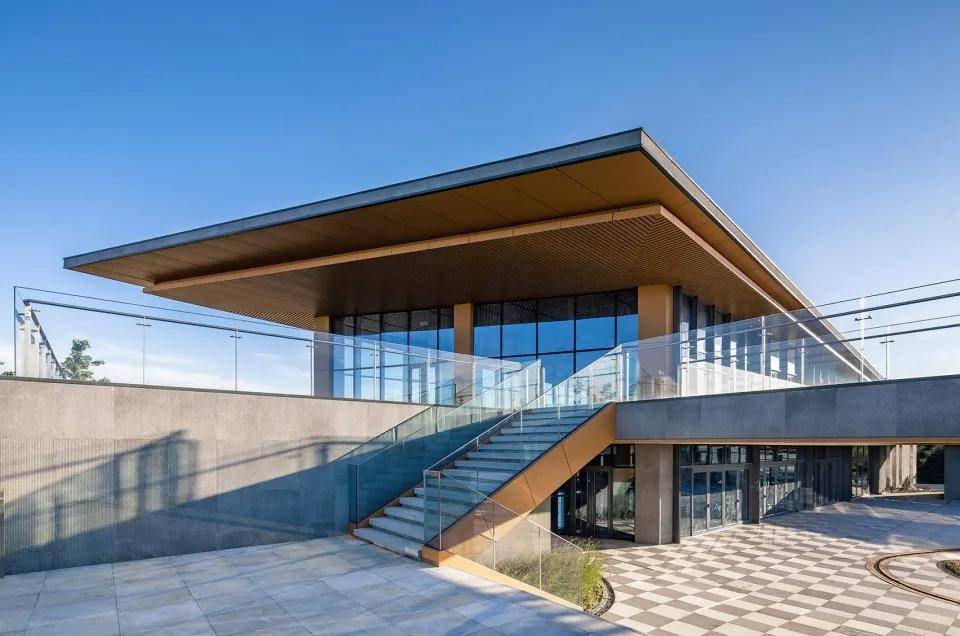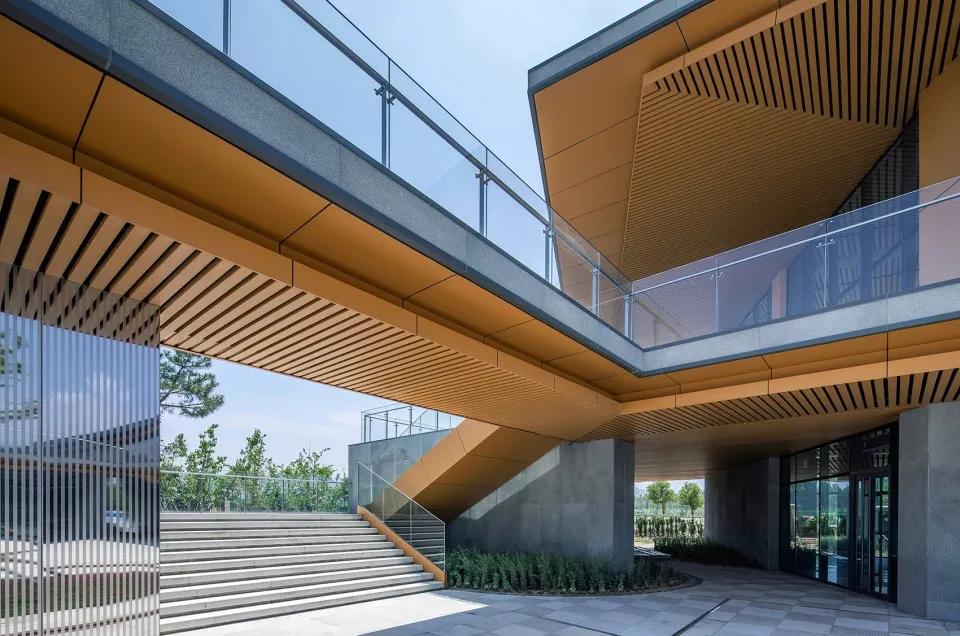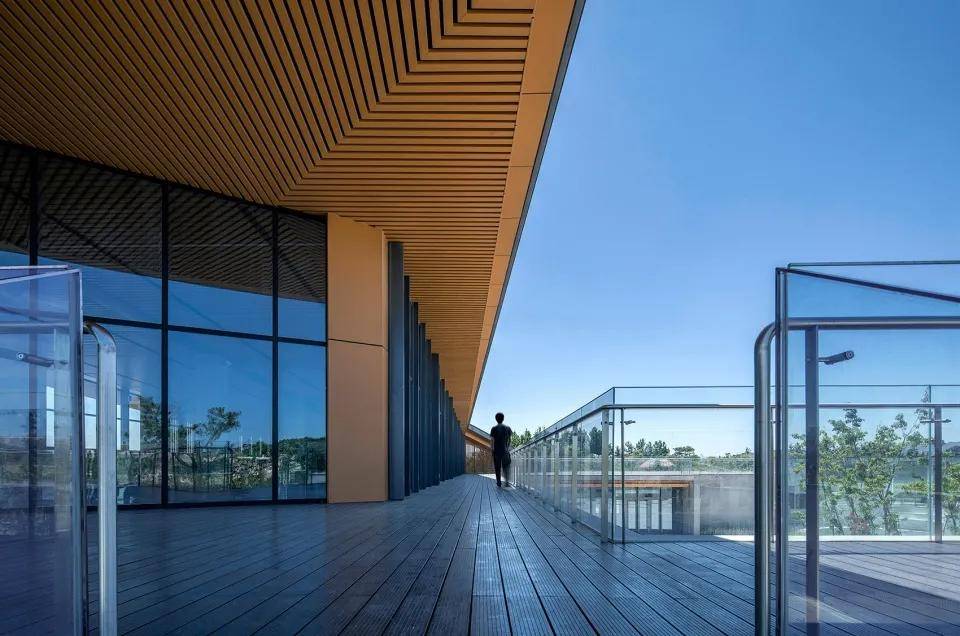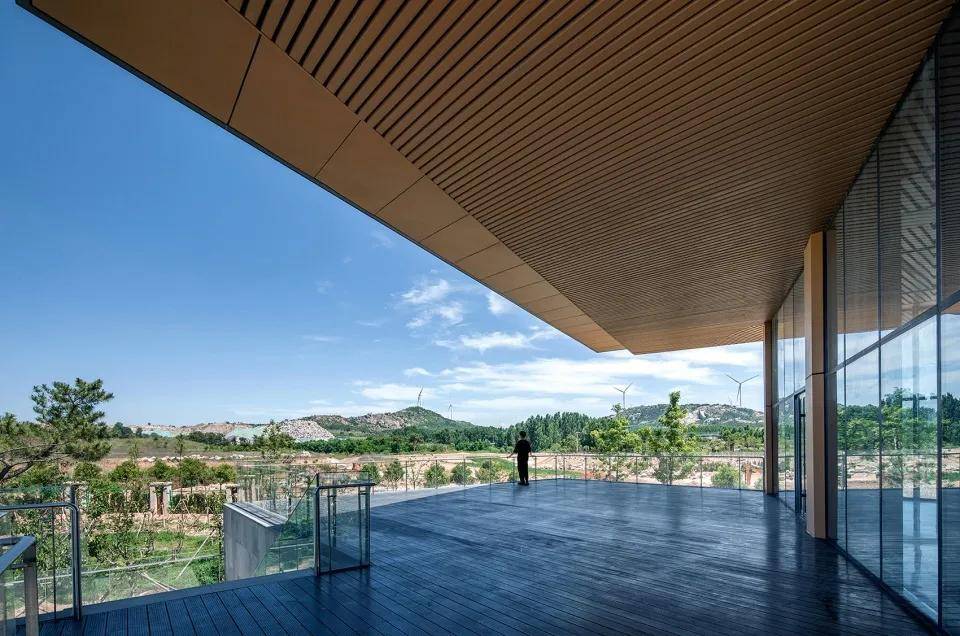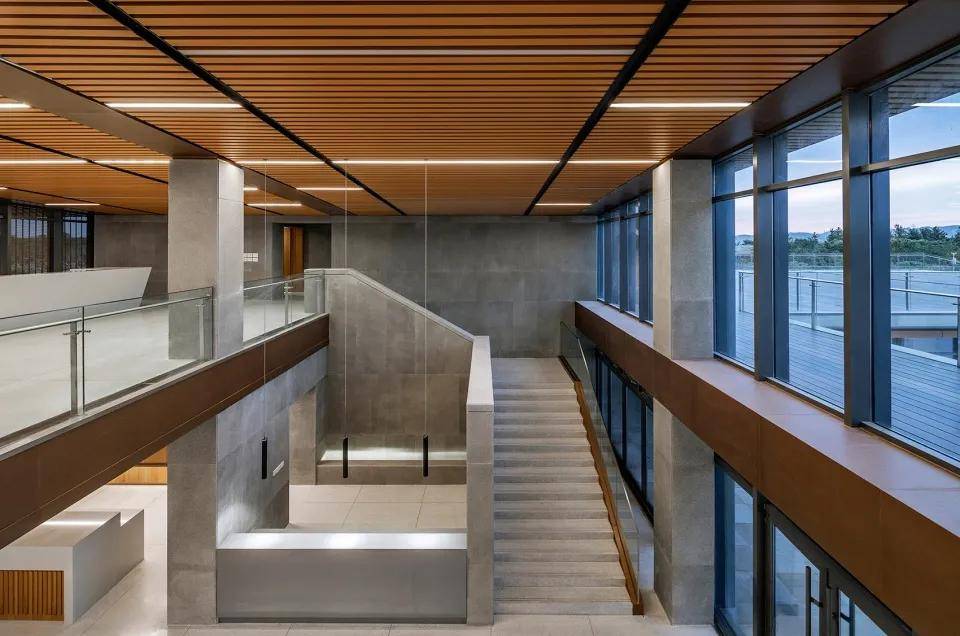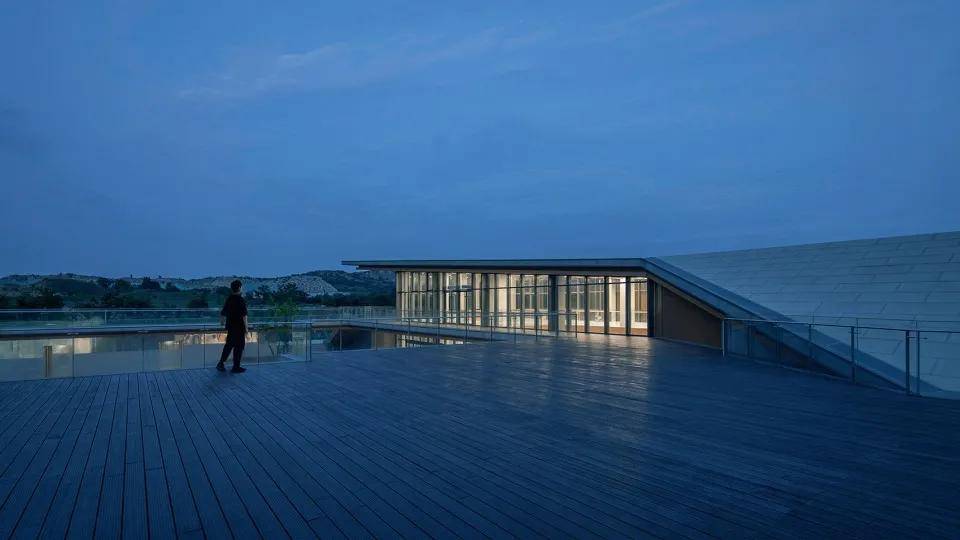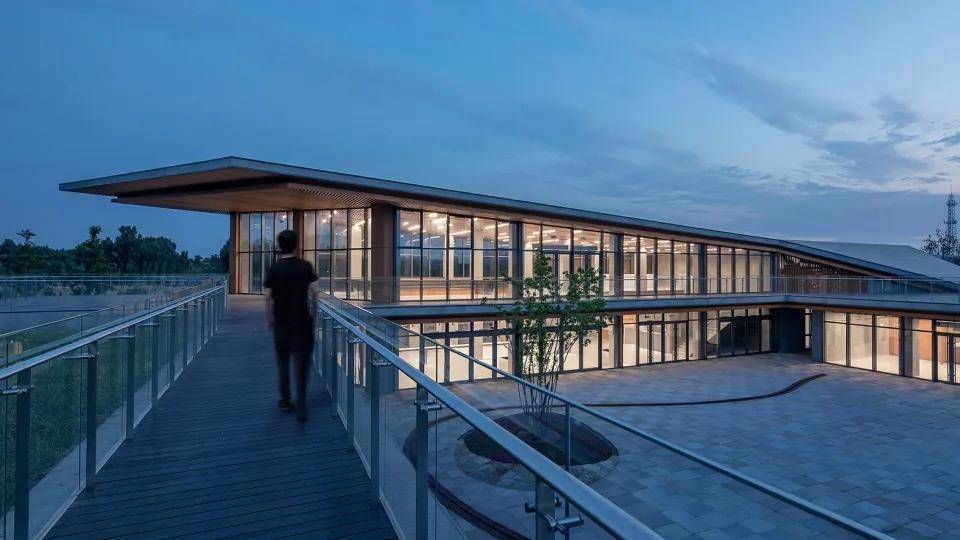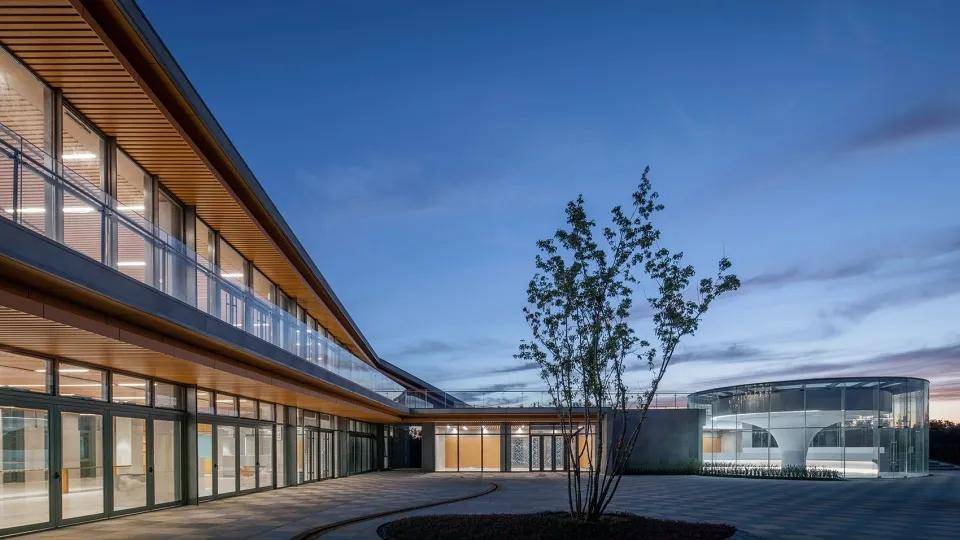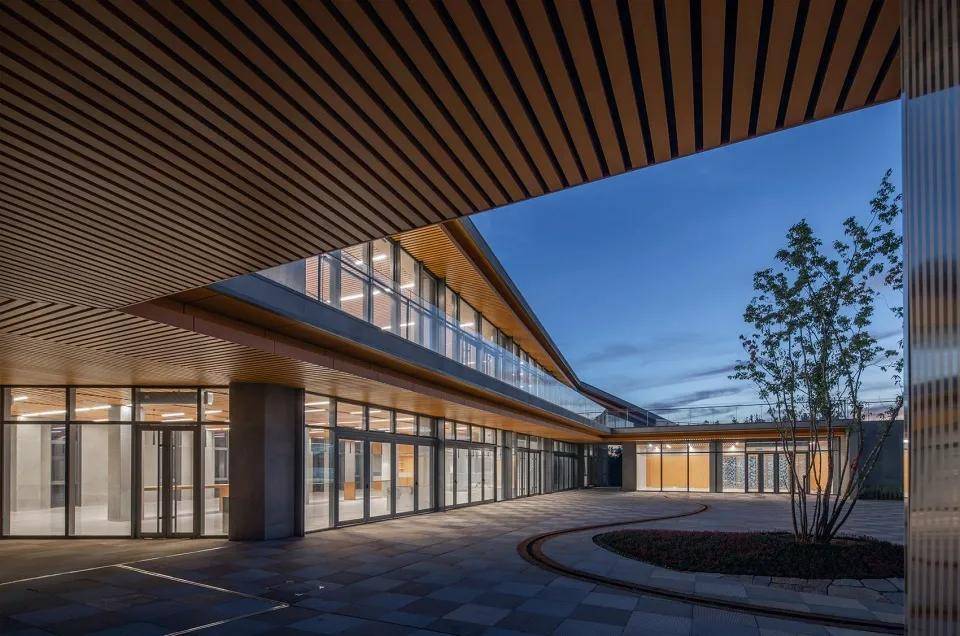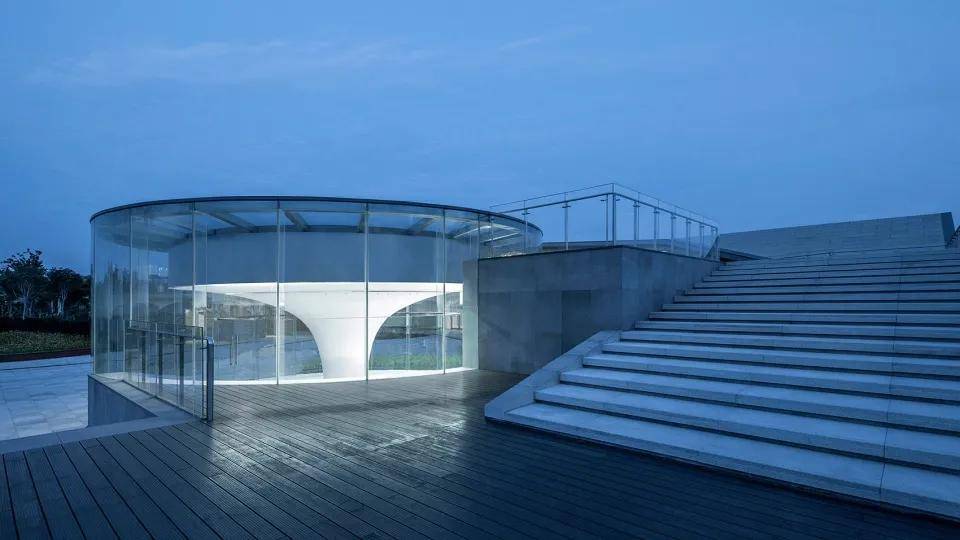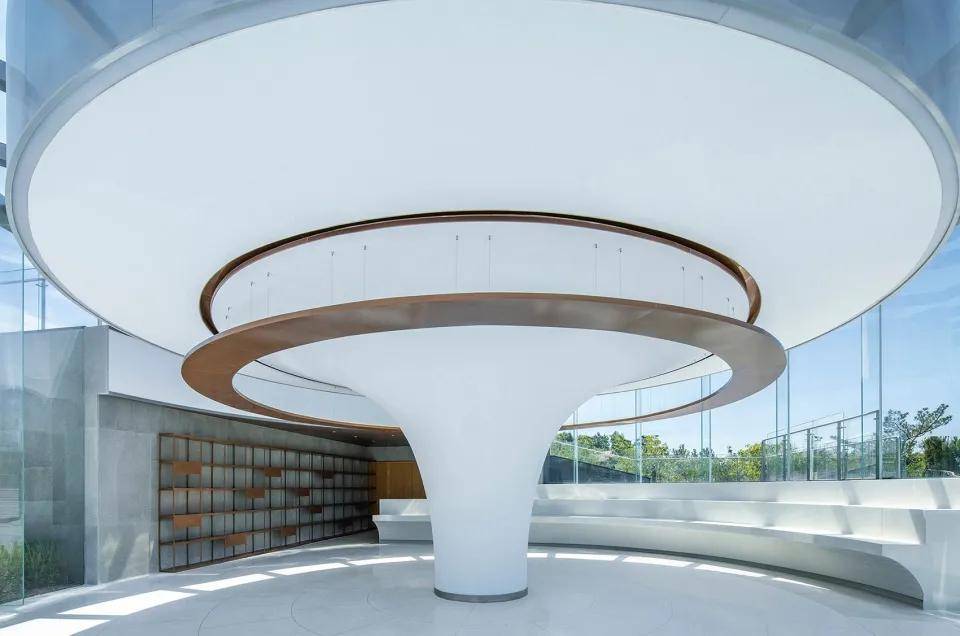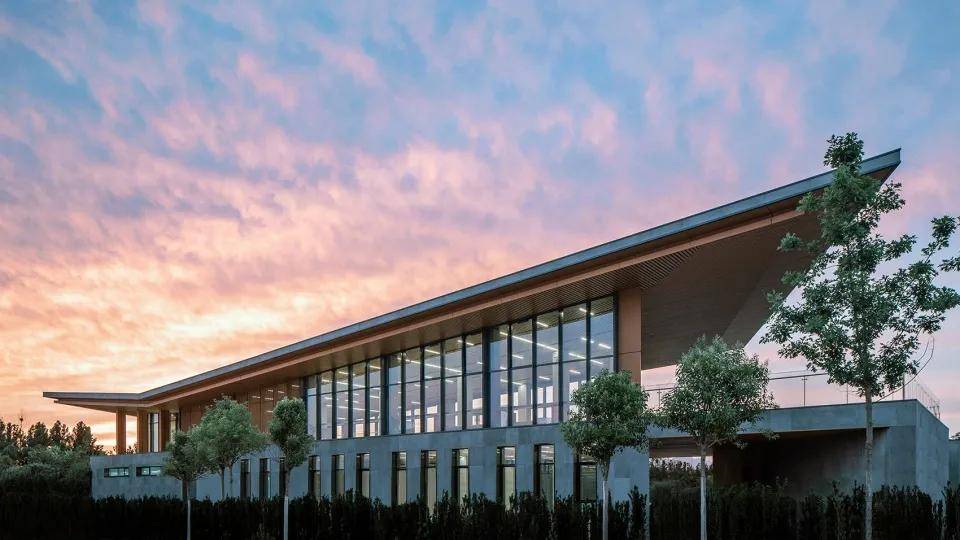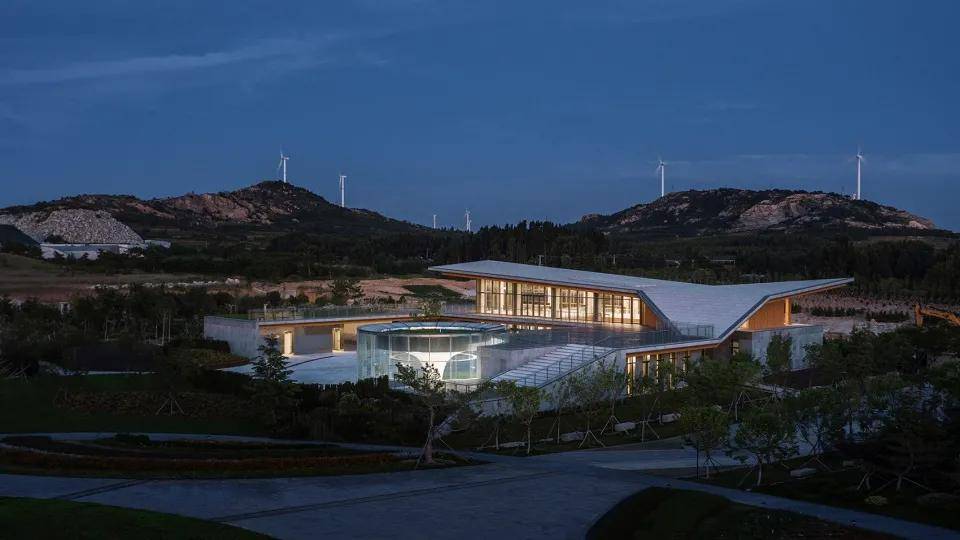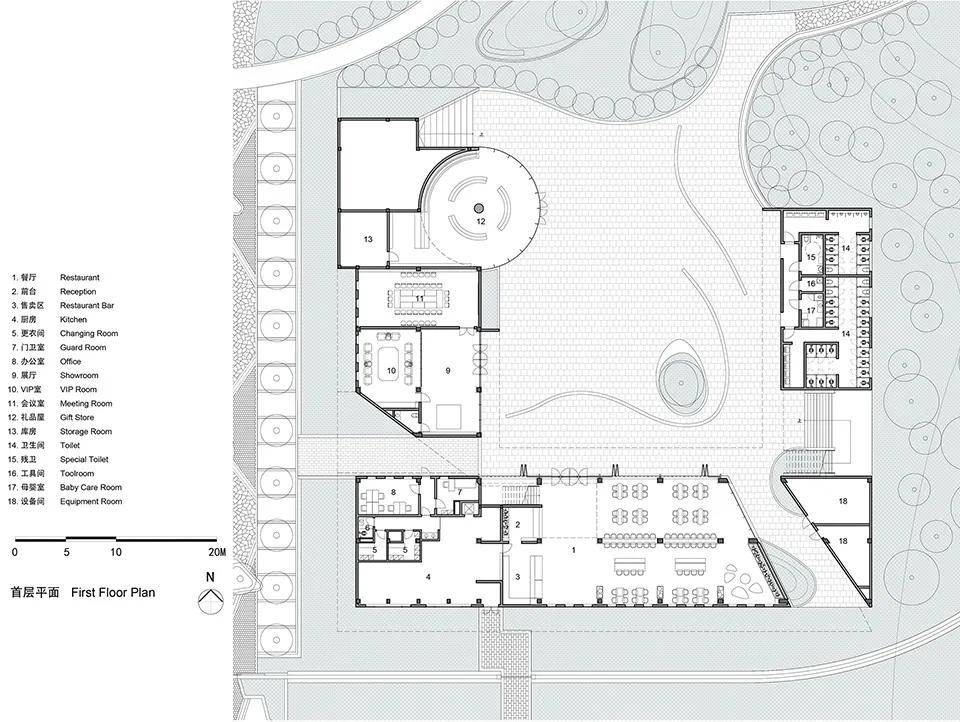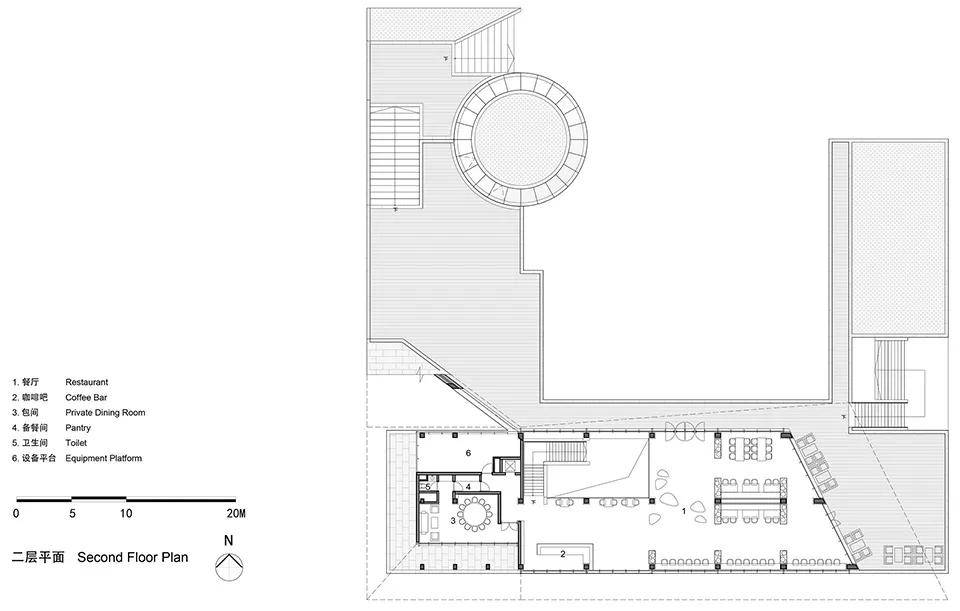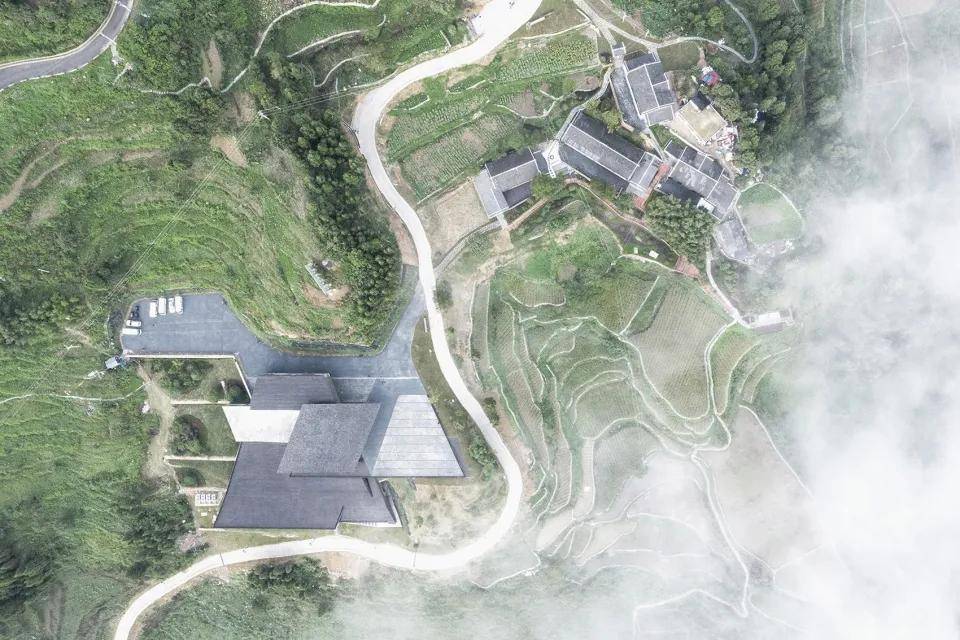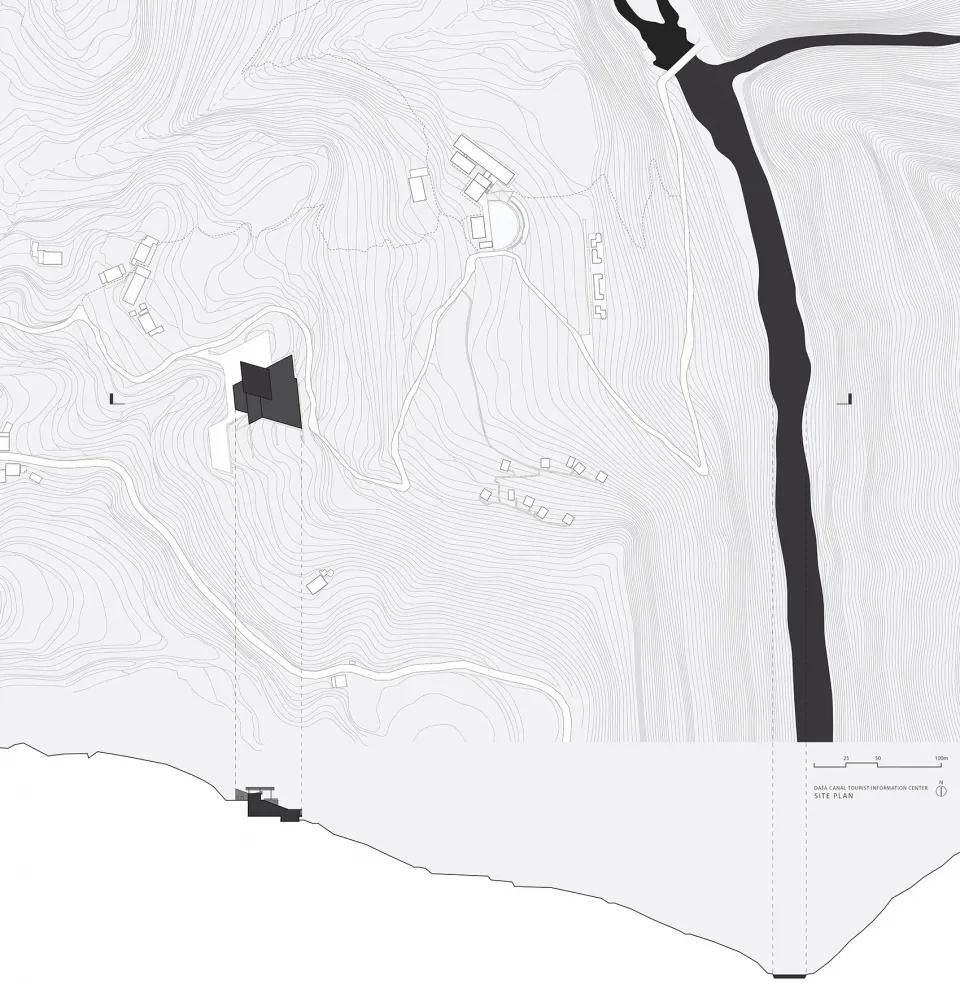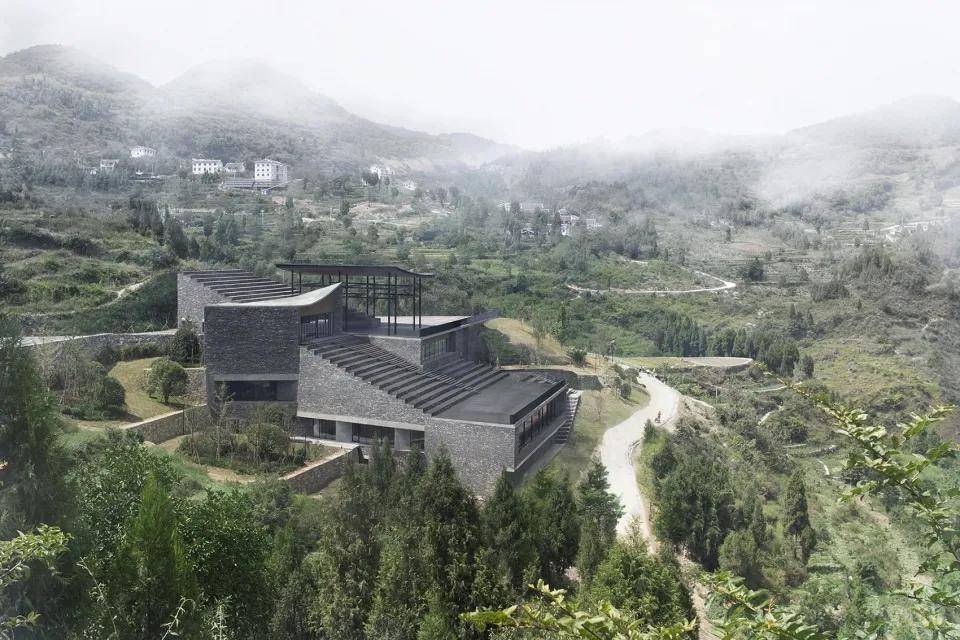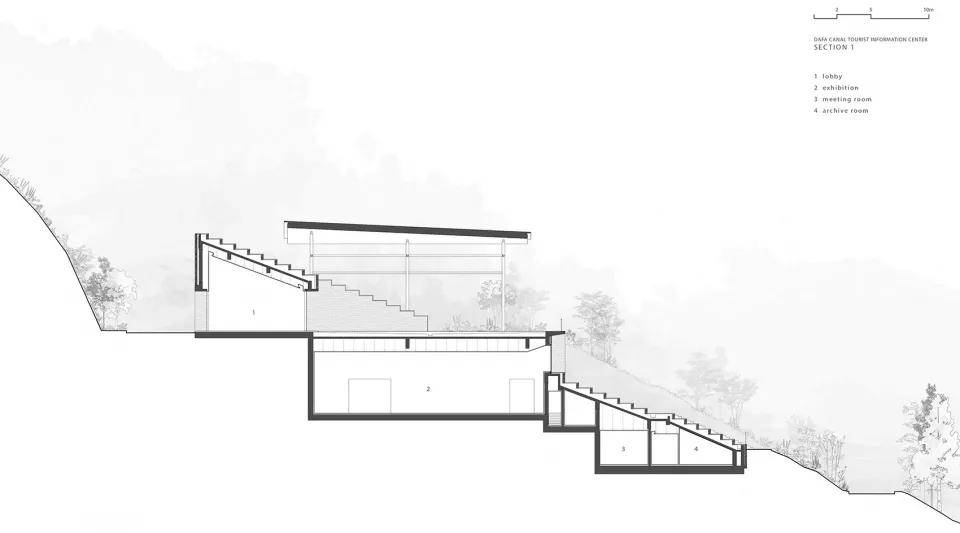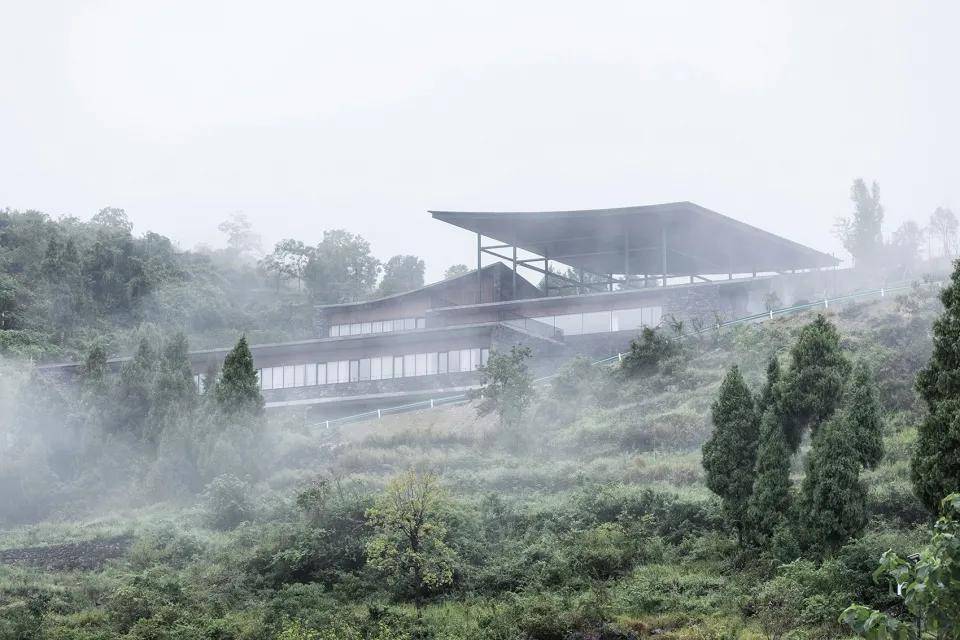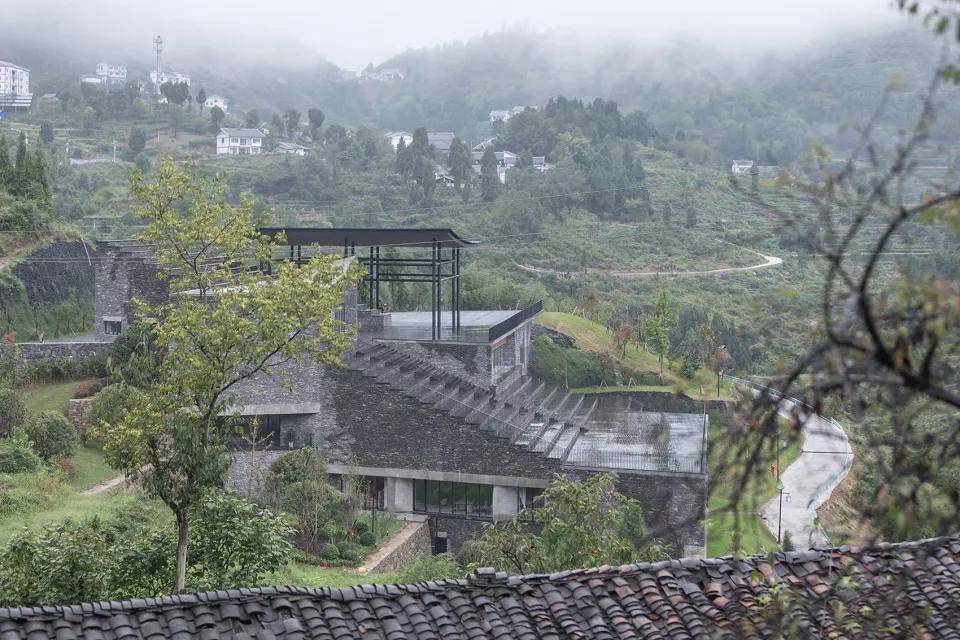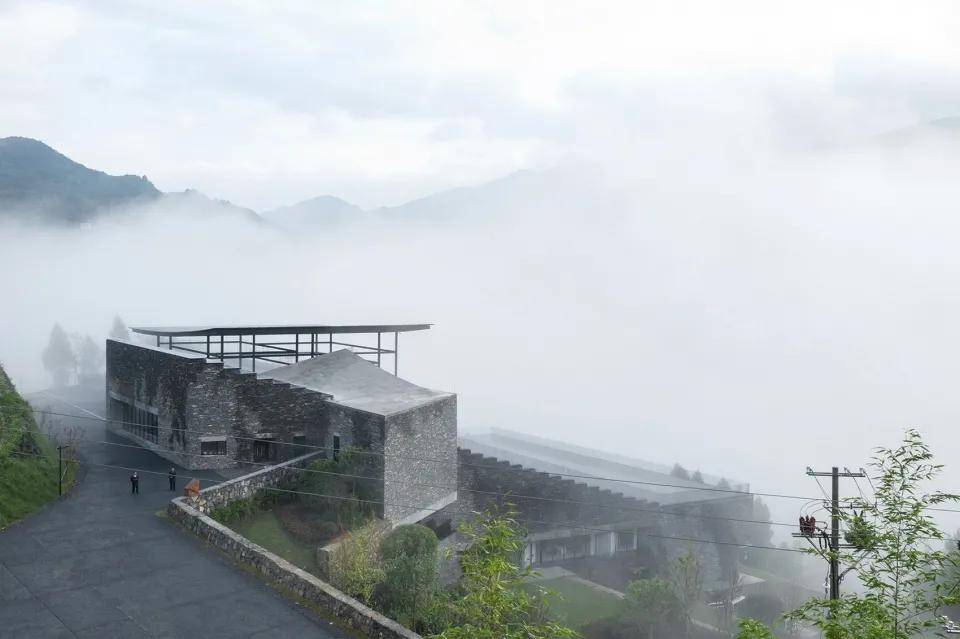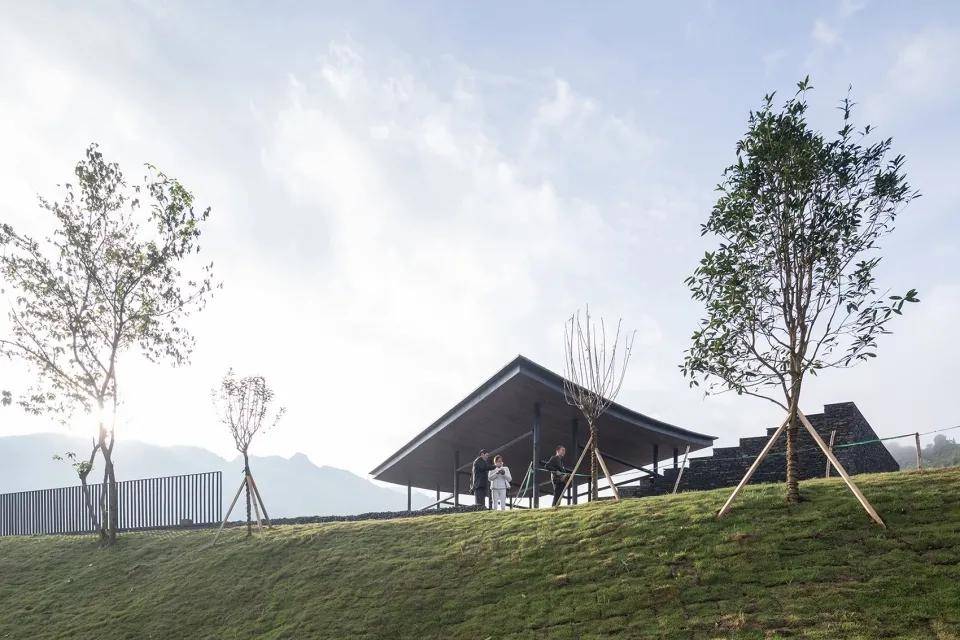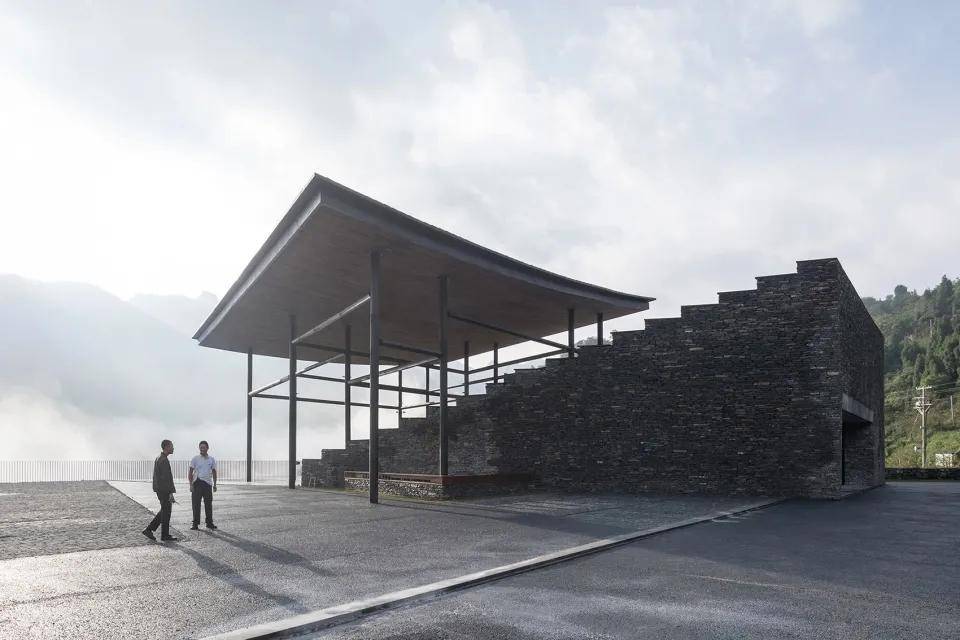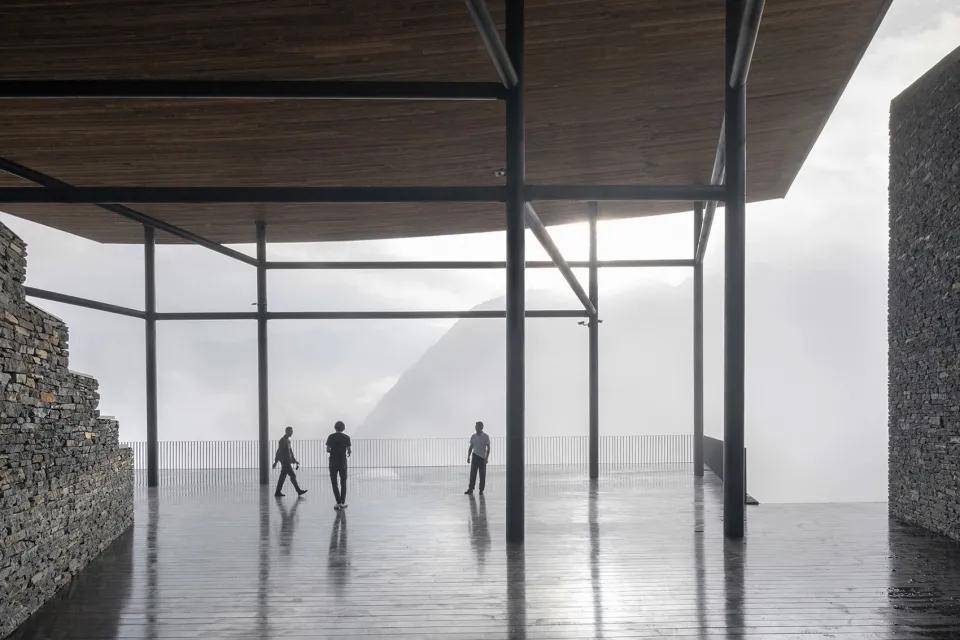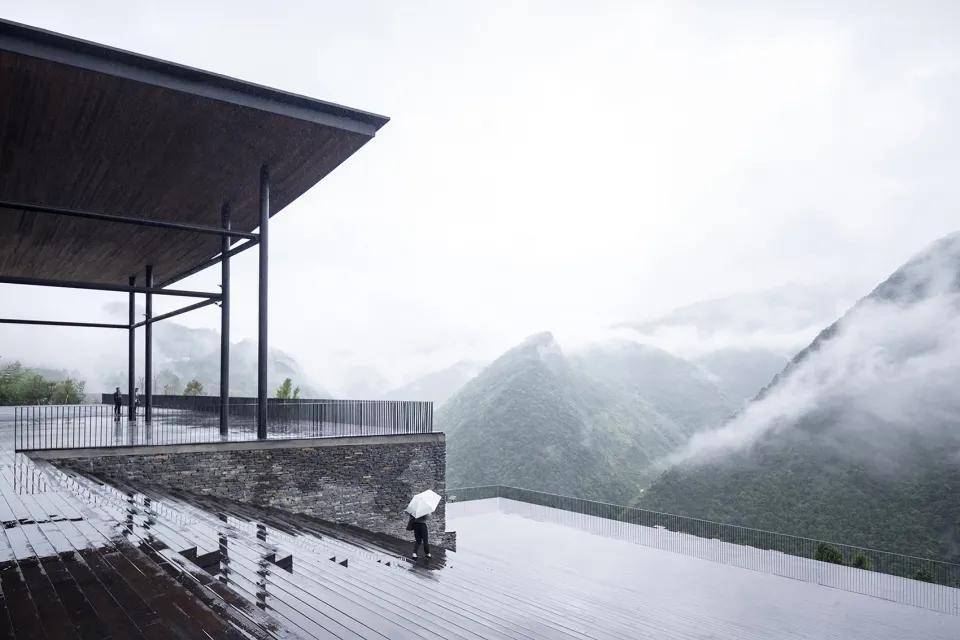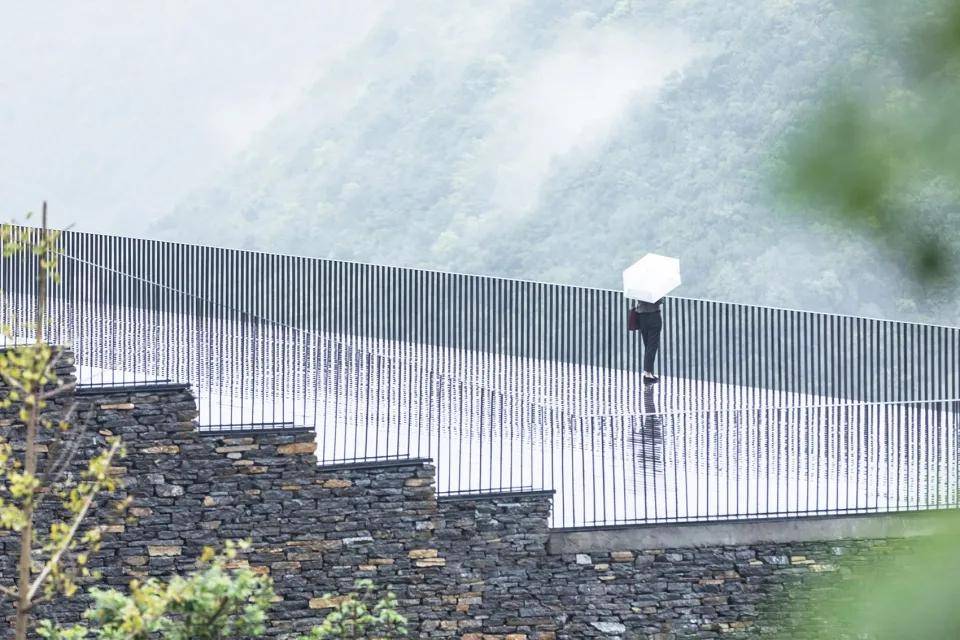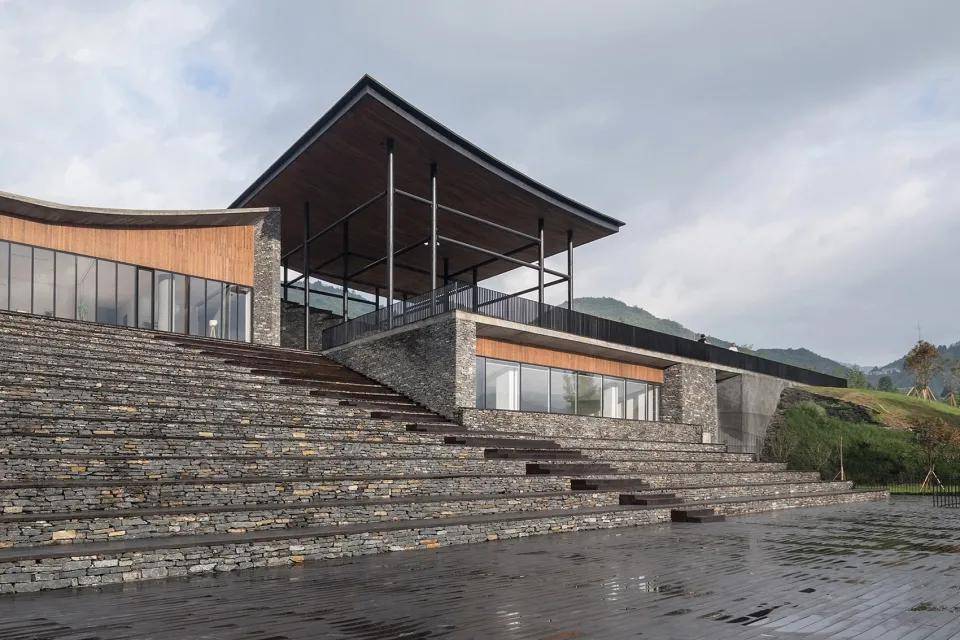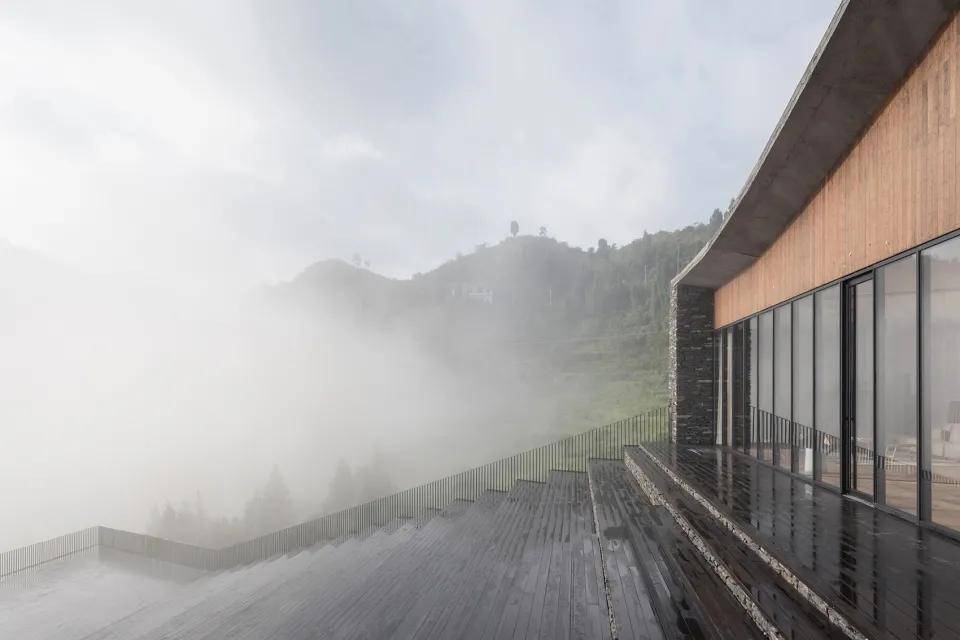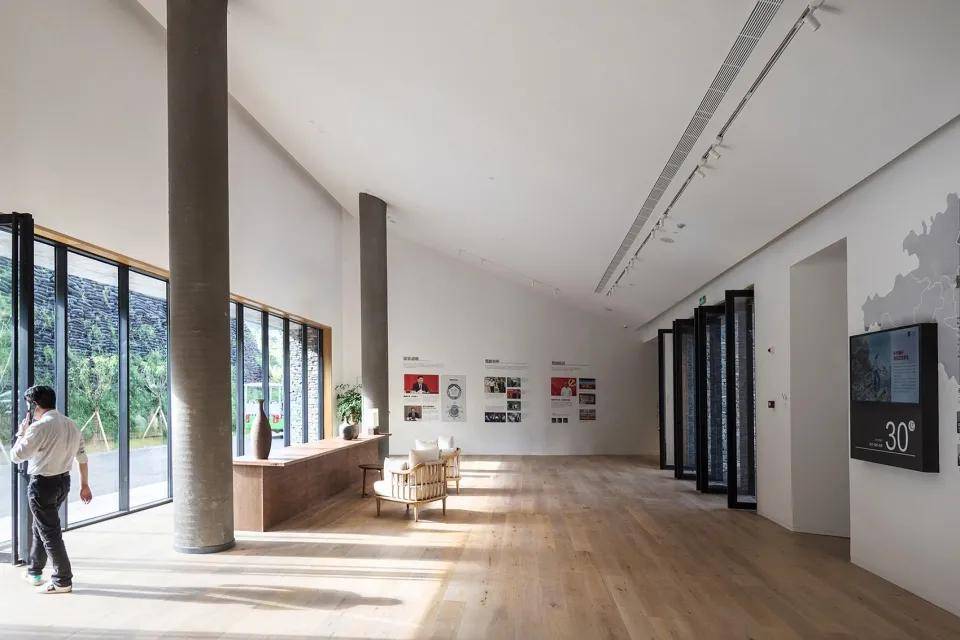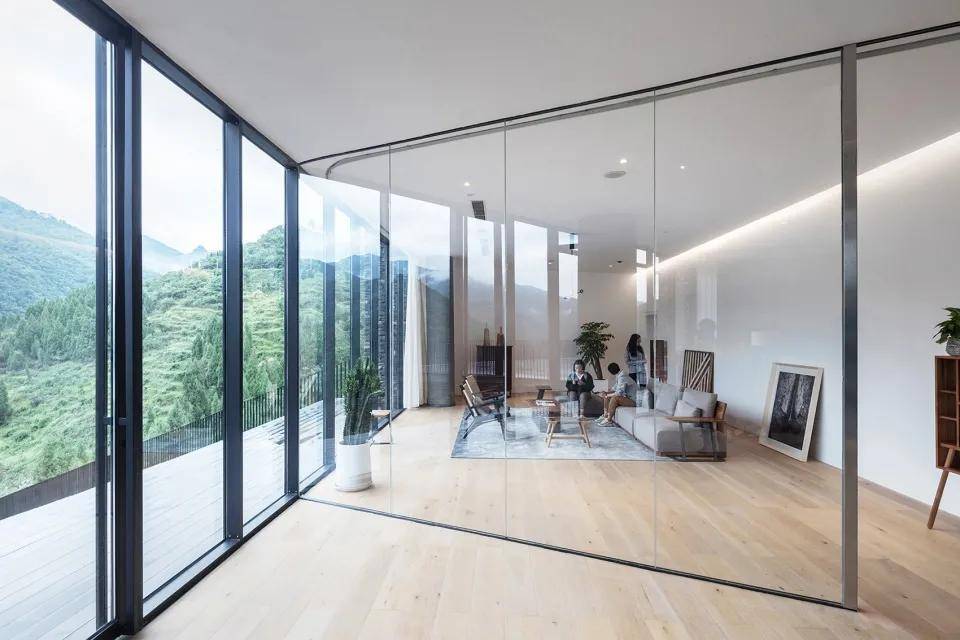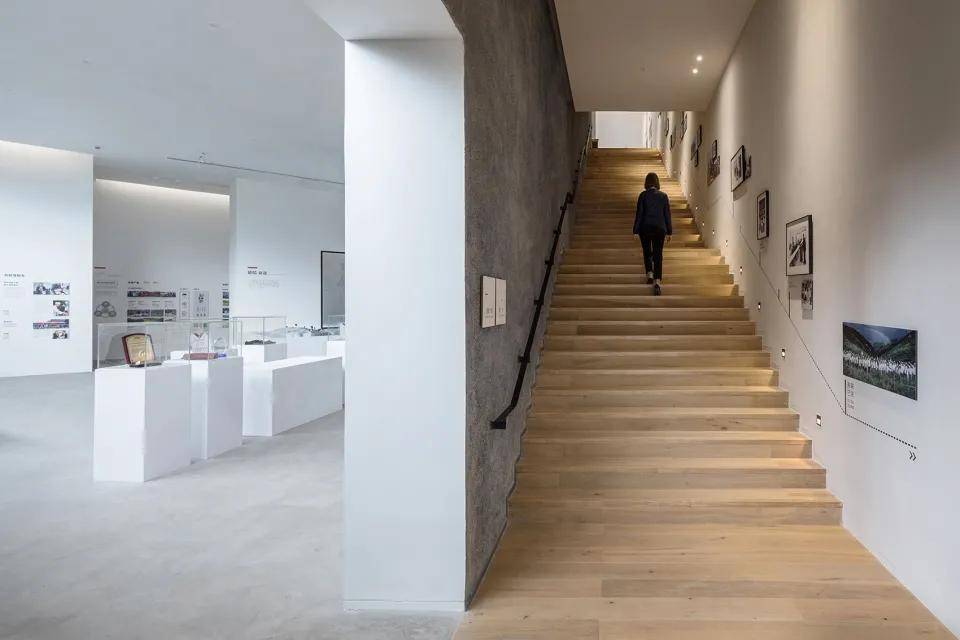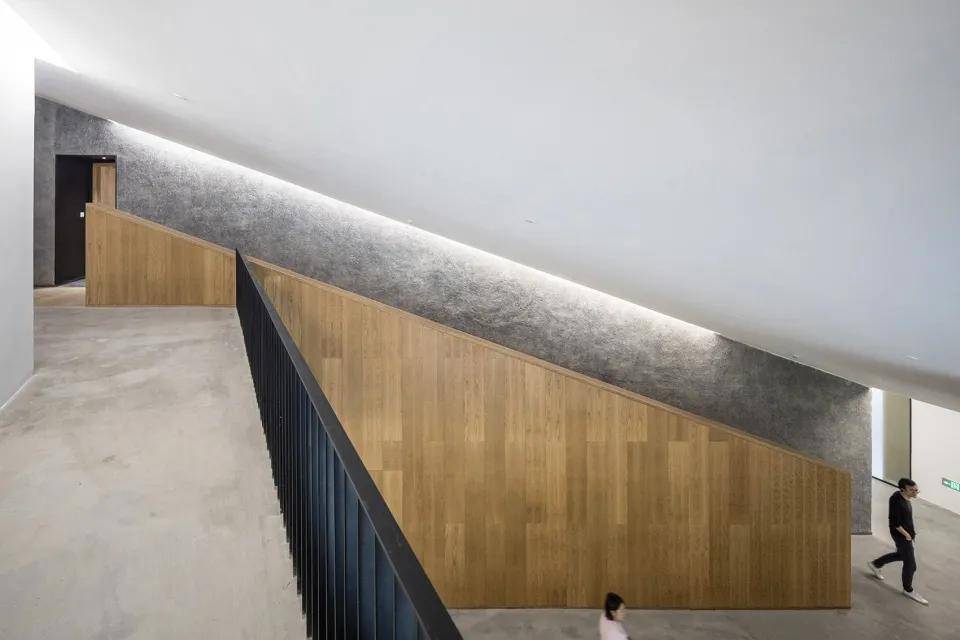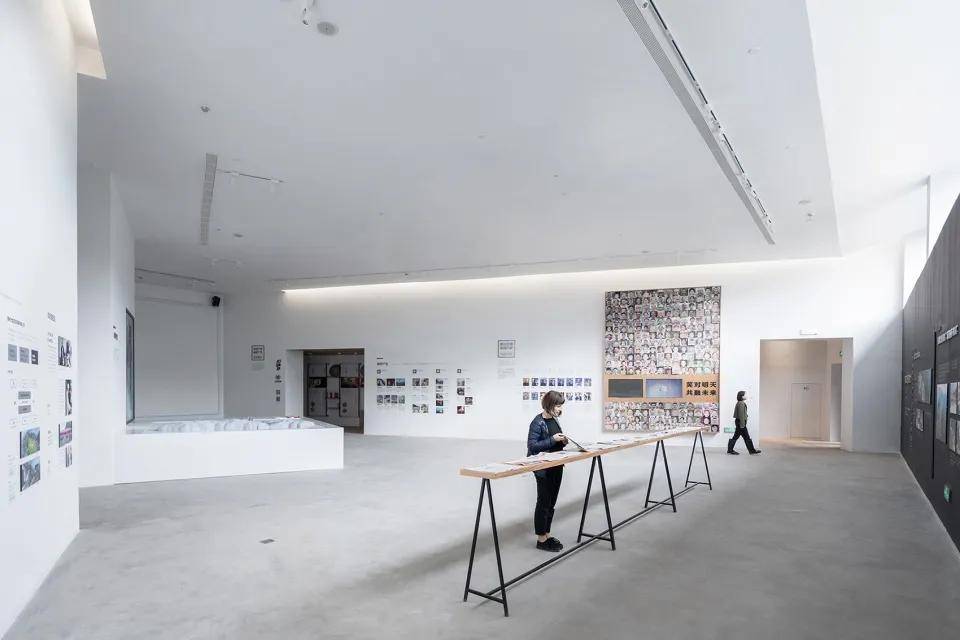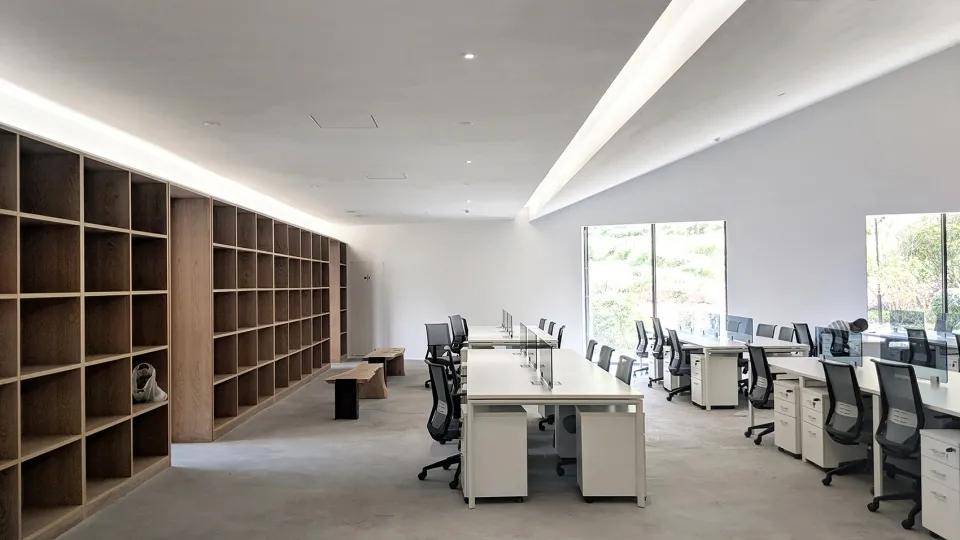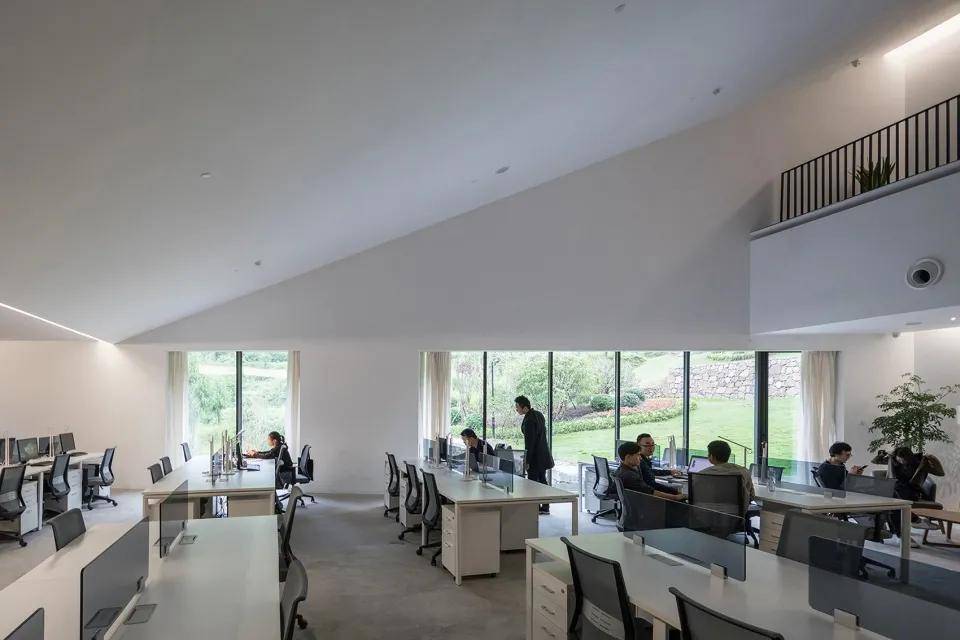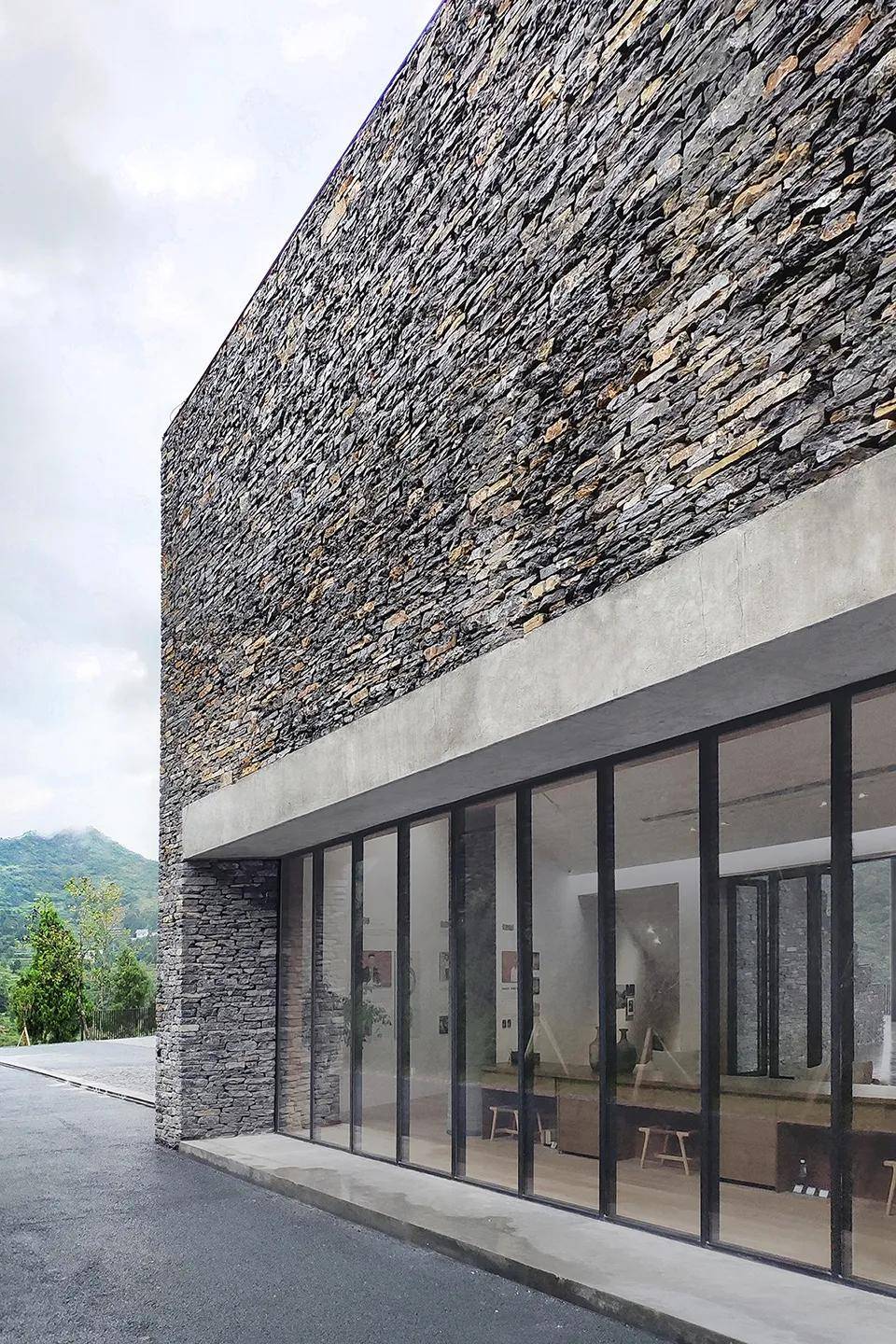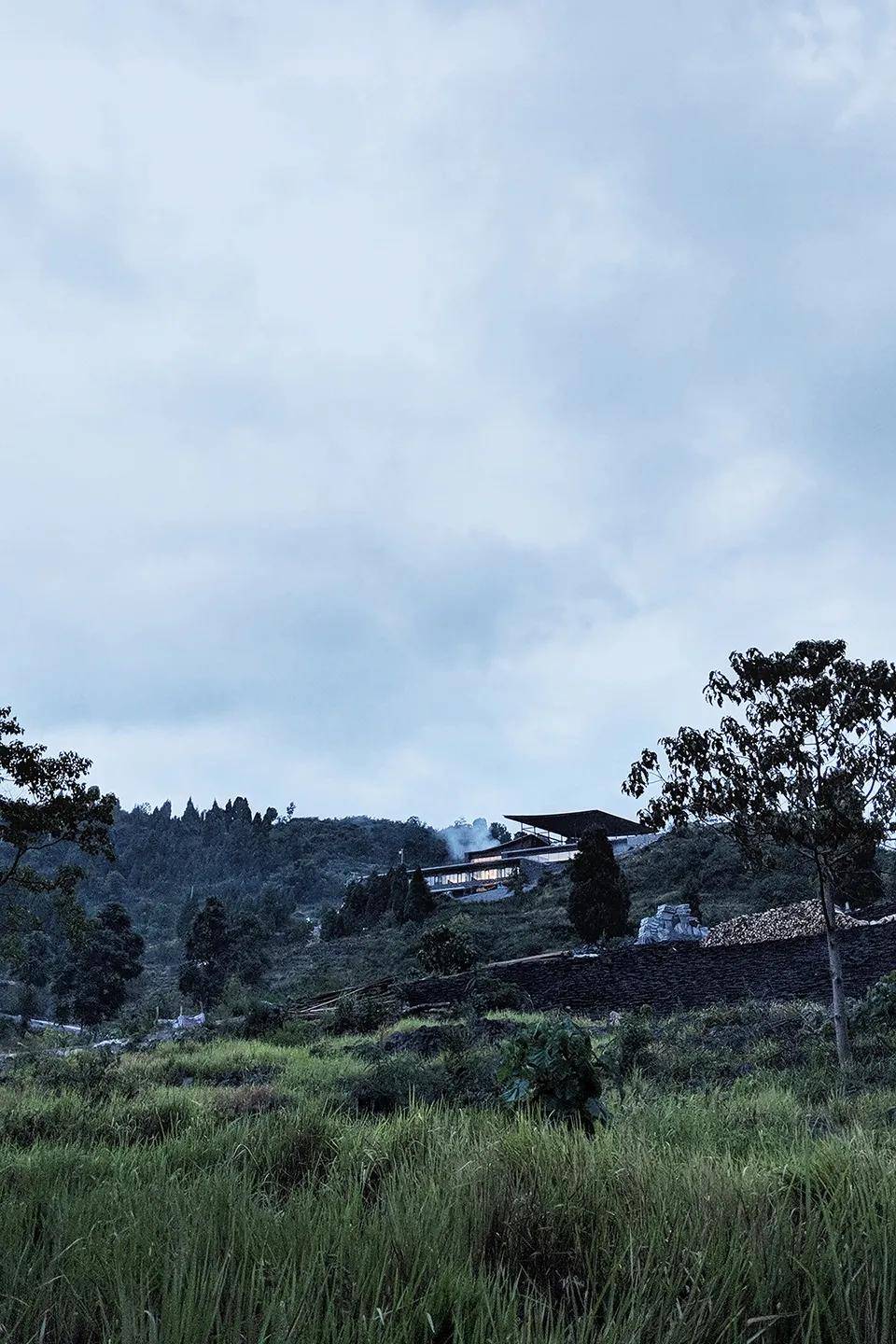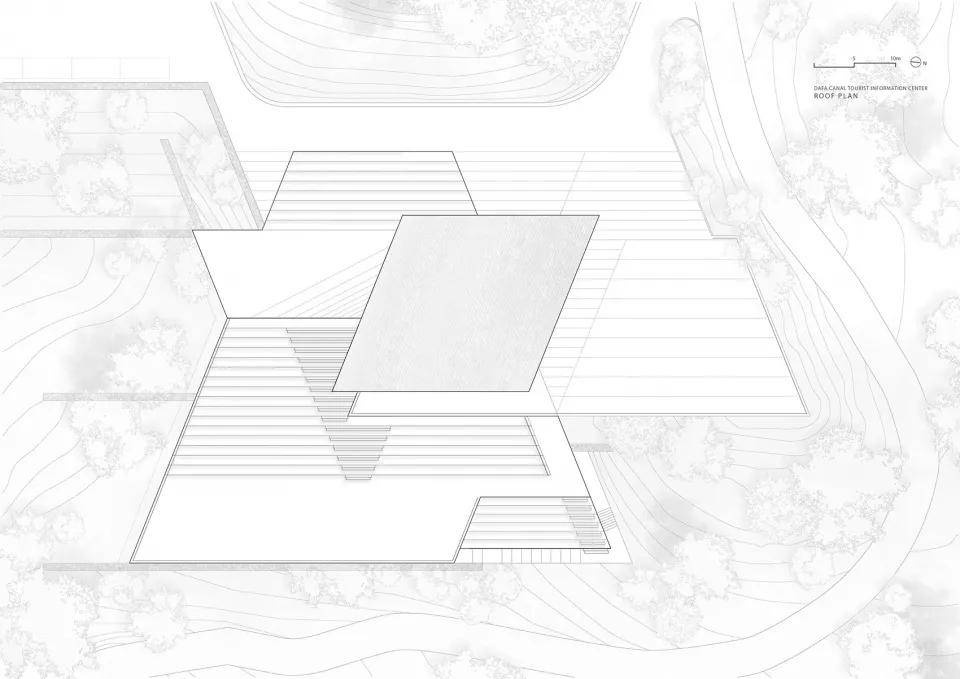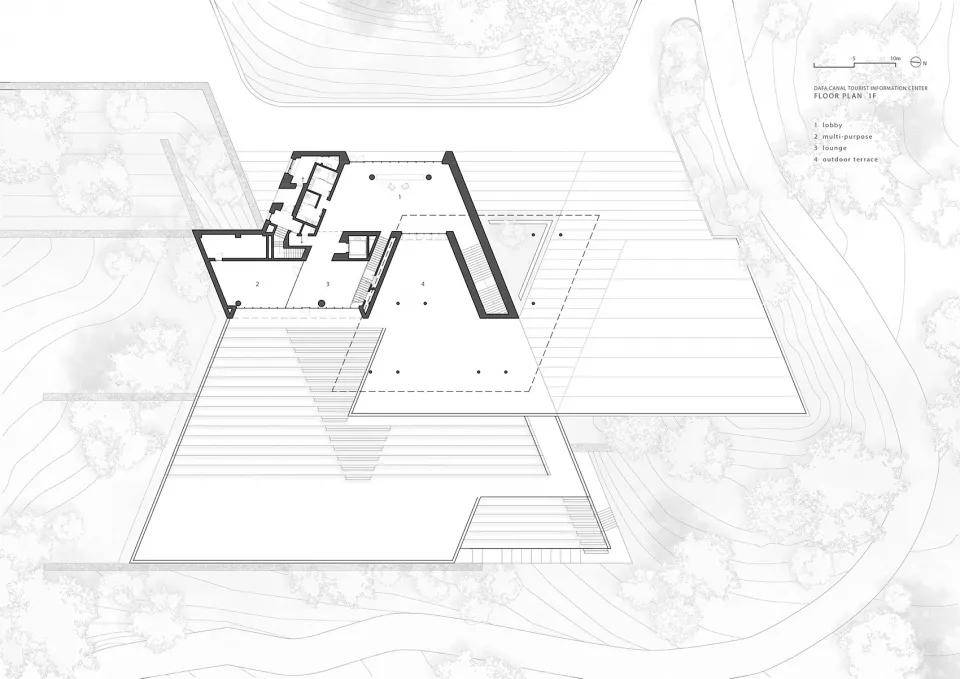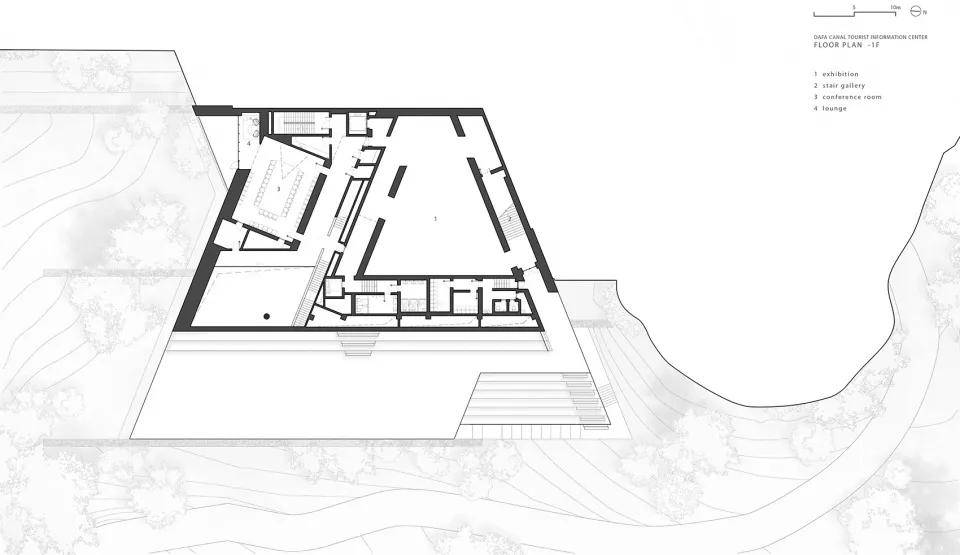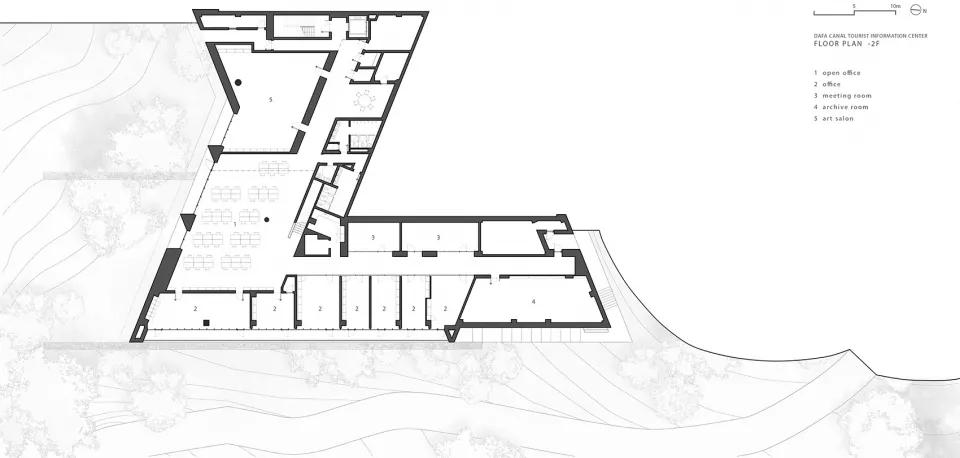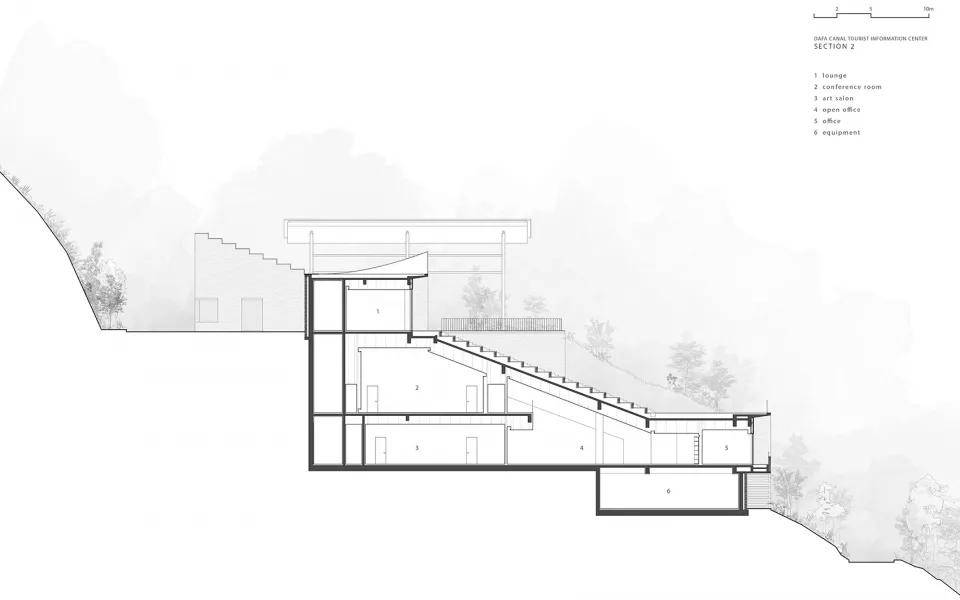| 建筑案例 | 您所在的位置:网站首页 › 公共建筑抄绘 › 建筑案例 |
建筑案例
|
▼形体生成,Form generation © UUA
▼轴测图,Axonometric drawing © UUA
设计概念:大地之痕 Concept: ‘A fissure of the earth’ 为了唤起场地的回忆,游客中心的设计概念取义“大地之痕”,用一种尖锐、强悍的建筑语言提醒人们这里曾经发生的生态破坏。‘裂痕’起自北端,建筑从大地中升起,向南缓慢爬升至二层,形成上扬的屋顶。作为一座景观中的建筑,连续的屋面模糊了大地与楼层的界限,水平展开的建筑体量与广袤的旷野和地下的岩层形成呼应。在这片经过修复的大地之上,用一种鲜明的建筑语言书写出根源于此的诗意。 ▼花园视角中的建筑,Viewing the building from the garden © 金伟琦
▼西侧通廊,A passage in the west © 金伟琦
▼暗藏的设备平台,The hidden building service platform © 金伟琦
▼屋面转角挑檐,A sharp corner of the roof canopy © 金伟琦
In order to make reference the site’s previous incarnation, the design concept of the Visitor Centre takes the meaning of ‘a fissure of the earth’, and uses a sharp and powerful architectural language to remind people of the ecological damage that has happened here. As The ‘fissure’ starts from the north, the building rises from the ground and ascends to the second floor as the form extends southwards. With the sense that the building is embedded into the landscape, the continuous roofline blurs the boundary between the ground and the floors, creating a sense of dynamic movement as it rises into the air at the southern point. The horizontality is defined by the buildings mass and langue of the elevation details echoing both the vast wilderness of its contextual setting and the strata of the ground below . ▼标高各异的露台,The terraces with different heights © 金伟琦
▼通往二层的台阶,Steps to the upper terrace © 金伟琦
▼室外连廊,The connection of terraces © 金伟琦
▼檐下空间望远山,View the mountains from a under canopy terrace © 金伟琦
▼室内中庭,The atrium © 金伟琦
总体布局:半围合式庭院布局 Configuration: A semi-open courtyard layout 面向北侧的花园景观,建筑采用半围合式庭院布局,包含餐饮、商店、展览、卫生间和园区管理等日常功能。建筑户外设有多个通廊、台阶和平台,形成了丰富的步行空间体验,让游客与建筑之间产生自然而积极的互动,同时也提供了观赏公园的多重视角。之于花园,建筑北低南高的态势也建构了一种和谐。 ▼大地之痕的意向,The image of a fissure of the earth © 金伟琦
▼由二层露台俯视庭院,Courtyard view from the upper terrace © 金伟琦
▼内庭院夜景,Night view of the courtyard © 金伟琦
▼檐下空间与庭院,Under canopy space and the courtyard © 金伟琦
▼玻璃花房夜景,Night view of the greenhouse © 金伟琦
▼玻璃花房的蘑菇柱吗,The mushroom like column in the greenhouse © 金伟琦
A central courtyard defines the heart of the complex, as daily activities from catering and shopping to exhibition display and property management are set out in rational and intuitive layout. The outdoor passages, steps and terraces interspersed between the built spaces create a rich walking experience, stimulating not only the interaction between tourists and the building, but also providing multiple perspectives for viewing the Garden. In summary being a poetic composition of harmony between a restored landscape and iconic architecture. ▼沿道路的南立面,South façade along the road © 金伟琦
▼室外露台与花园,Terraces and the garden © 金伟琦
▼西北角夜景鸟瞰,Aerial view from the northwest © 金伟琦
▼首层平面,First floor plan © UUA
▼二层平面,Second floor plan © UUA
▼立面图,Elevations © UUA
▼剖面图,Sections © UUA
项目名称: 七色山矿坑花园游客中心 设计方:UUA建筑师事务所 项目设计&完成年份: 11/2017-03/2019 建筑面积: 1700平方米 摄影版权: 金伟琦 Dafa Tian Qu Visitor Centre 大发天渠旅客中心 坐落於群山之中的大发天渠旅客中心,地处贵州所辖的偏远山村——团结村,它是在政府扶贫政策引导之下,通过农业旅游改善贫困农村经济的项目之一。融合着政治使命和理想主义,该建筑已然成为团结村的新地标,推动着周边地区的进一步发展。 Located in the remote village of Tuanjie, the Dafa Canal Tourist Information Center is one of the first projects of a new government policy to help ameliorate rural poverty through the introduction of agricultural tourism. The building aims to become a new centerpiece in the village, catalyzing further development in the area. ▼场地鸟瞰,aerial view of the site
中国乡村建筑的风貌是这几年被频繁触及的议题。相对其他拥有较多文化遗产的先例,这个曾经的贫困村并没有可传承的典型传统建筑形式,而山、河、苍翠的景观是它最大的资本。因此,大发天渠旅客中心的设计以另一个角度切入这个人文贫瘠的场地: 不强加符号式的传统建筑元素,而是强调与自然环境和谐衔接。大发天渠旅客中心的建筑体量由当地石材堆砌成的外墙及暗色的竹地板组成,审慎地融合在原始景观中,而阶梯状的屋面完全开放给旅客及村民“来屋顶上坐坐”。这个大型公共集散空间结合室内办公运营、接待展示的空间,正逐渐改变当地乡村的公共生态,成为一股激活当地乡村发展的驱动力。 ▼场地平面图,site plan
Recent years have seen hurried attempts by architects to preserve the disappearing traditional architecture in rural China. However, unlike other rural areas Tuanjie village has little traditional architecture to hold on to. Instead, its striking landscapes provide a new inspiration for a rural architecture that blurs the boundary between building and nature. Dafa Canal Tourist Information Center combines office and exhibition program under a stepped public roof that merges into the surrounding landscape, serving as a new platform for local public life. ▼项目概览,project overview
基地 | Location 决定基地及建筑朝向是设计的一个关键点。山中没有红线范围或是退界,我们希望建筑能饱览周边景色,但未开发的陡峭地貌限制了选择的范围,山势险再加上有限的施工周期,道路的建设和建筑施工只能同时进行——应对施工难度与效率成为重要的制约因素。最终大发天渠旅客中心落在一处具有10米高差的天然梯台上,正对着远山与河,带来具有冲击力的观景感受。同时,道路与建筑西侧连接,于北侧急转而下,低于建筑通过东侧往低处延伸,不影响建筑正面的观景效果。场地的条件决定了许多建筑设计手法,流线的衔接、灵活地过度场地高差,以及将葱郁景观最大限度地融入每一个空间成为建筑最主要的特点。 ▼剖面图,section
Nestled amongst the steep mountain surroundings, the building is set on a natural platform with a 10 meter elevation difference and beautiful views of the nearby river and mountains. The stepped form is born out of the linked constraints of site, access and views. In addition, the concurrent construction of the site road and a strict project schedule enforced a rigorous approach to the project development. In the end, the constraints which shape the project form the distinctive characteristics of the tourist center. ▼大发天渠旅客中心落在一处具有10米高差的天然梯台上, the building is set on a natural platform with a 10 meter elevation difference and beautiful views of the nearby river and mountains
▼建筑正对着远山与河,带来具有冲击力的观景感受,the stepped form is born out of the linked constraints of site, access and views
建筑概念 | Architecture Concept 团结村与周边乡镇一样,原始的乡村建筑元素已渐渐被新时代快速化的农村建设替代,村中多处新建筑在原生态的山景中略显突兀。我们希望旅客中心能够为新农村建设提供另一种范本,“不破坏大山与乡村原本的样子”,寻求新建筑与乡村景观的融合。游客中心的建筑倚山成形,顺山势布置,阶梯状的屋顶减少体量的压迫感,并呼应两侧农村的梯田风景;建筑自高至低逐渐增加宽度,形成上窄下宽、面向群山敞开的观览平台,沿著平台往下走,视野愈加开阔,来客可以在这里清晰地感受自然的原始力量。从山下仰视时,建筑体量错落有致,像是数个小型建筑的相互叠加,形成类似于传统村寨的形象。建筑外墙由当地的暗色石材砌成,附近民居院落常见相似的毛石矮墙,与原生村落的建筑元素形成呼应。 Many of the contemporary village buildings nearby were quickly built and are not fitting with the landscape in shape or concept. The tourist center suggests a different approach for village development which celebrates and elevates context through building. The stepped façade clad in local stone emerges directly from the landscape in both form and material, humanizing the scale of the building and working directly with the topography of the site. When viewed from below, the building reads as a composition of smaller volumes, harmonizing with the surrounding nature and village. The steps becomes a stage for the public with a background of mountains, clouds and trees. ▼阶梯状的屋顶减少体量的压迫感,the stepped façade clad in local stone emerges directly from the landscape in both form and material
▼建筑外墙由当地的暗色石材砌成,the building is cladded with locally quarried dark stones
▼檐下空间,the sheltered space
▼观景平台,viewing platform
空间 | Space 灰色方石铺设的室外广场是将游客引至主入口的迎客平台,以木瓦为材料的架空大屋顶衔接广场与大厅, 形成开敞的半室外空间,鼓励来客在此驻足停留。室内空间设计简洁,根据尺度、功能,以不同方式适当引入景观及光线,营造多样的空间体验。建筑沿山势形成3个主要的室内标高,由两个直跑楼梯衔接各层空间。一侧的办公区楼梯连接入口大厅、展览区域及办公区域; 另一侧直通展览区域的公共楼梯是展示空间的一部分,将展览流线流畅地从入口大厅延续至大展厅以及室外的观景平台,形成连续性的观展体验。 A floating canopy of wood tiles connects the entrance plaza and lobby with a semi-outdoor space that encourages people to linger. The interior spaces are stepped, responding to the hilly site with framed views of the mountain landscape introduced in each space. The interior design is simple and serene, putting focus on the exhibition and surrounding nature. Two stairs link the different levels. One connects meeting and office facilities and the other serves as a gallery stair, forming a continuous exhibition space that leads visitors to an outdoor public terrace. ▼以木瓦为材料的架空大屋顶衔接广场与大厅,a floating canopy of wood tiles connects the entrance plaza and lobby with a semi-outdoor space that encourages people to linger
▼入口广场,entrance plaza
▼入口大厅,lobby
▼休闲客厅,lounge
▼公共楼梯是展示空间的一部分,the public stair functions as a part of the exhibition space
▼展览空间,exhibition area
▼办公区域,office area
村的改变是个过程,以大发天渠旅客中心为起点,还有更多的可能性,将随着美好建筑的发生而发生。 Positive changes in the village have already begun to appear, and with Dafa Canal Tourist Information Center as a catalyst, more possibilities and changes will soon be seen. ▼立面细部,facade detail
▼夜景,night view
▼屋顶平面图,roof plan
▼首层平面图,plan level 0
▼-1层平面图,plan level -1
▼-2层平面图,plan level -2
▼剖面图1,section 1
▼剖面图2,section 2
项目名称:大发天渠游客中心 设计:休耕建筑 项目设计 & 完成年份:2018 主创及设计团队:曹振宇, 陈宣儒, 沈洪良, 蔡玉盈 项目地址:贵州, 中国 建筑面积:3280 m2 注:本文仅供学习交流,如涉及作品内容、版权和其它问题,请及时与我们联系,我们将在第一时间删除,感恩您的理解包容。返回搜狐,查看更多 |
【本文地址】
